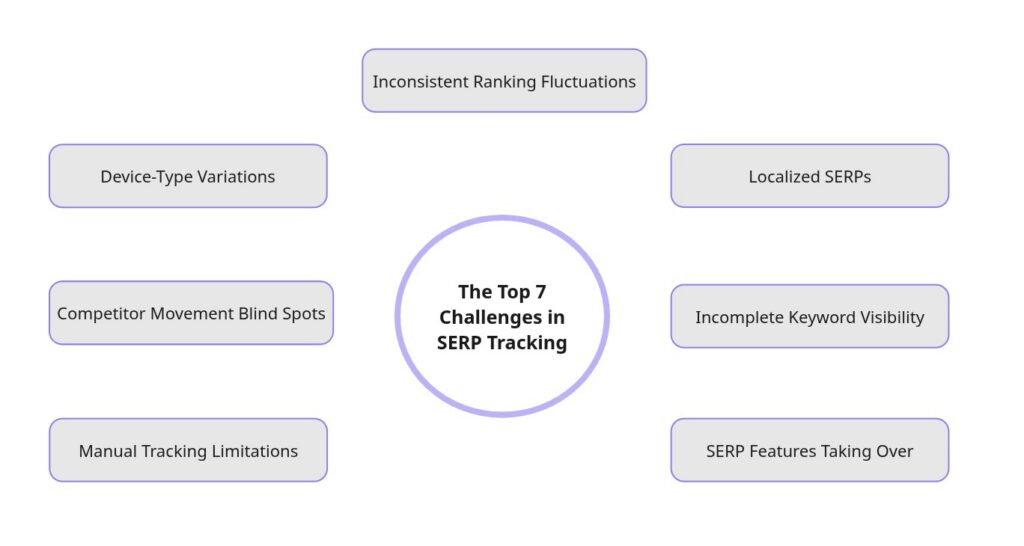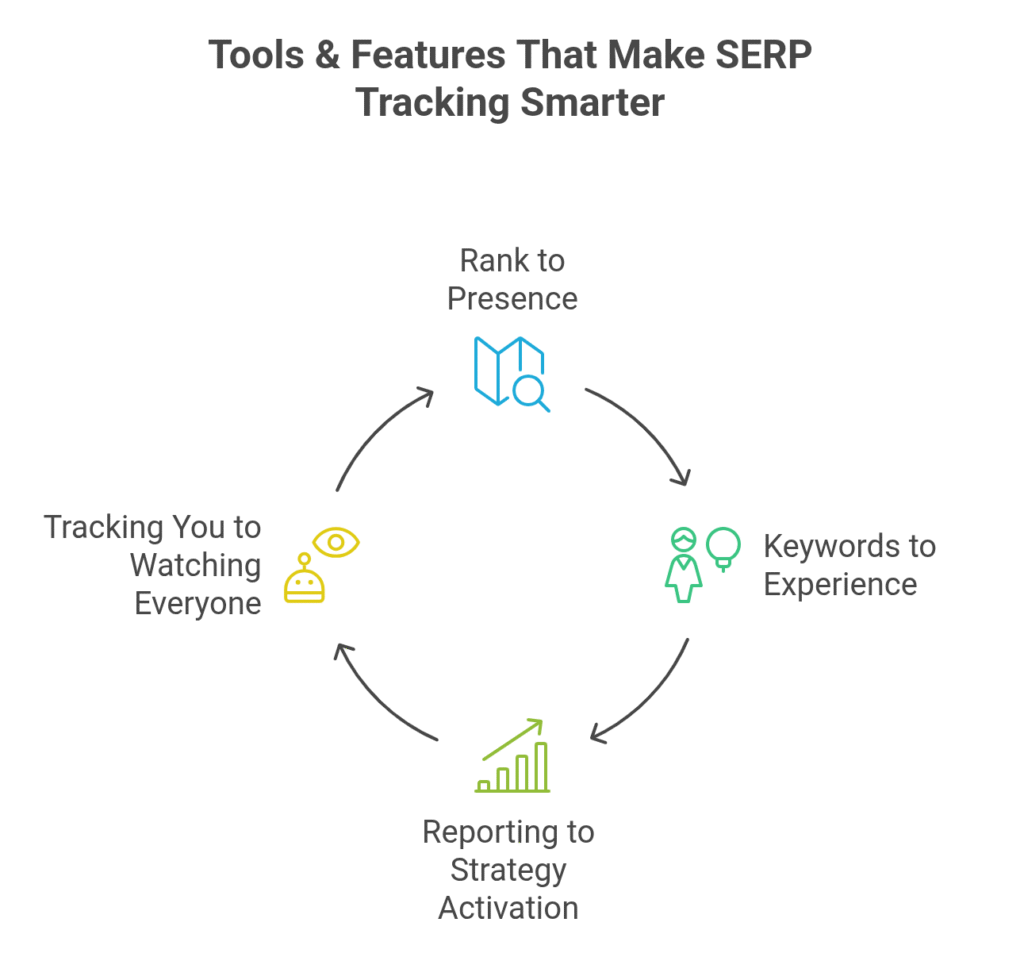Challenges in SERP Tracking That Most Teams Overlook
10 min read
10 min read

Table of Contents
Table of Contents
On the surface, SERP tracking sounds like a basic function: plug into a keyword, check your rank, adjust your SEO plan – done. But in the real world of search marketing, it is far more complex. Challenges in SERP tracking stem from the fact that the search results are no longer stable or universal. Search engines now tailor results based on user location, device type, search history and intentions. This means that what you see in one place can be completely different from what you see your customer elsewhere.
Features like geo-focused search results and mobile-first indexing have basically modified how rankings are measured. Add in the constant algorithm updates and rank volatility, and you are looking at a tracking environment that shifts each day—sometimes even hourly. It’s now not sufficient to track a few keywords from one location or on a desktop device. You want granular, accurate, real-time data just to keep up. Without it, you’re probably basing vital SEO selections on previous or misleading data.
This is where most brands are surprised. They assume that their rank data is accurate, but metrics usually do not reflect what real users are really seeing. And when your data is turned off, your strategy is deactivated. This is why understanding the main challenges in SERP tracking – and knowing how to solve them – is essential to remain competitive in today’s SEO game.

Tracking rankings may seem like a numbers game, but the reality is far more layered. As search engines evolve, the challenges also make measuring true visibility. It’s no longer about just knowing where you rank – it’s about knowing why the ranking is changing, who you compete against, and how different users see completely different SERPs. Whether you run local campaigns, monitor global positions or try to decode SERP features, understanding the full scope of these challenges is what sets the Smart SEO team apart from the lost.
SERP rankings aren’t fixed — they shift constantly based on algorithm changes, search intent, and even user behavior. What ranks today could disappear tomorrow without any changes on your end. This search engine volatility isn’t random — it’s tied to how Google adapts results dynamically, often influenced by freshness, seasonality, or engagement metrics.
Why it matters:
Google serves different results based on geography, device, language, and even search history. A keyword that ranks #2 in California could be invisible in London. If your SERP tracking doesn’t simulate different user environments, you’re working with data that’s only half-true.
Key impacts:
Too many SEOs focus on a handful of high-volume keywords, but most conversions happen through long-tail queries, product variations, and user-intent-driven searches. Worse, when several of your pages target similar terms, keyword cannibalization happens — and it’s one of the biggest silent killers of ranking performance.
What goes wrong:
Ranking #3 doesn’t guarantee clicks anymore — not when Google fills the top half of the page with featured snippets, video carousels, image packs, local maps, and “People Also Ask” boxes. This is the new reality of SERP feature dominance, where organic links compete for attention on crowded, interactive SERPs.
What you might miss:
Spreadsheets, browser checks, and DIY scripts might feel manageable early on, but they don’t scale, and they’re full of blind spots. Manual tracking is reactive, slow, and completely unreliable for capturing today’s SERP complexities. Most importantly, it’s often inaccurate by the time reports are shared.
Limitations include:
Most teams track their keywords, but not their competitors’. That’s a major mistake. If a rival grabs a featured snippet, outranks you for a transactional keyword, or suddenly surges in local visibility, you’ll only notice it after you’ve lost traffic. By then, it’s too late.
What you need to track:
With mobile-first indexing now the default, mobile rankings should be the priority, but many brands still rely on desktop-centric tracking. The problem? Mobile SERPs often look completely different, with fewer results, more features, and distinct user behavior patterns.
Why it matters:
The challenges in SERP tracking don’t just create technical obstacles — they reshape how SEO strategy is planned, executed, and measured. If your tracking doesn’t reflect real user behavior or the current SERP landscape, your strategy is already one step behind.
When ranking data is inconsistent or incomplete, it leads to confusion. Your team might think a page is losing traction when in reality, the SERP layout simply changed — perhaps a featured snippet appeared, or a local pack pushed your listing down. Without that context, you’re chasing fixes that won’t actually help.
Then there’s the issue of search intent. If your tracking doesn’t account for how user behavior changes across locations or devices, you’ll end up optimizing for keywords that don’t match what your real audience is looking for. That mismatch leads to lower engagement, even if you technically “rank.”
One of the most overlooked effects is on organic visibility. You could rank #4 and still have minimal traffic if SERP features are dominating the top of the page. Many teams don’t realize how much click-through rate (CTR) is being stolen by snippets, carousels, and PAA boxes, because their tracking tools only show position, not what users actually see.
All of this creates a chain reaction:

Bad tracking → Wrong data → Misguided SEO choices.
And that’s not just inefficient — it’s risky.
To stay competitive, your strategy must evolve with how modern SERPs actually function.
Fixing SERP tracking isn’t about chasing one issue at a time. It’s about building a smarter, layered system that sees the full picture.
If the challenges in SERP tracking have one thing in common, it’s this: they come from complexity. Devices, locations, SERP features, search intent — all variables that change what people see and how tools report it. So instead of reacting to problems individually, smart SEO teams approach tracking like a layered system.
Below is a three-layer framework designed to solve all common SERP tracking issues, not just patch them.
Most mistakes happen at the input stage — tracking the wrong keywords, ignoring intent, or relying on single-location checks. This layer is about refining your tracking strategy before the tools even come into play.
What to do at this layer:
You can’t track modern SERPs with outdated tools. This layer is all about upgrading your rank tracking tools, dashboards, and automations to handle complexity across devices, regions, and SERP formats.
What to set up here:
The goal of tracking isn’t data — it’s decisions. This final layer focuses on translating rankings into informed SEO strategies that drive traffic and increase visibility.
How to activate this layer:

What’s Changing, What’s Coming, and Why You Should Rethink Your Tracking Stack
2025 isn’t about “better tools.” It’s about tools that ask better questions.
The old mindset — track keyword, get position, report it — is over. Why? Because the challenges in SERP tracking today aren’t about tracking rank. They’re about tracking reality.
The biggest shift we’re seeing this year:
SERP tools are moving from “position watchers” to “SERP interpreters.”
They’re learning to decode intent. To simulate behavior. To spot not just where you rank, but how search visibility, competitors, and layout shifts change, and why you rank.
So instead of another roundup, here’s what the next generation of SERP tracking actually looks like:
Tools are shifting from static “you’re in position #4” tracking to presence modeling.
That means:
2025 tools aren’t just about tracking keywords — they’re recreating full search journeys.
Think of it as:
Tools are finally moving past dashboards and into SEO strategy engines.
They auto-suggest:
Old tools tracked your site only. New platforms track your entire SERP environment.
What’s happening in 2025:
Live updates. Instant insights. Every second counts.
2025 tools are moving toward these 3 breakthrough directions:
At its core, SEO is about trust, not just from users, but from your own team. You can’t build confident strategies, pitch reliable reports, or scale winning campaigns without knowing that your rank tracking reflects reality. And right now, for many teams, it doesn’t.
Why? Because the challenges in SERP tracking have evolved. We’re no longer dealing with one static set of results. Search is now dynamic, location-sensitive, device-dependent, and increasingly dominated by non-organic elements like featured snippets and zero-click answers.
But here’s the upside: these challenges aren’t roadblocks — they’re signals. They show us where old systems are failing and where new visibility opportunities are opening up.
When you invest in smarter tracking tools that reflect context, intent, and SERP layout, you’re not just “checking positions.” You’re making smarter decisions, faster. You’re reclaiming control of your strategy.